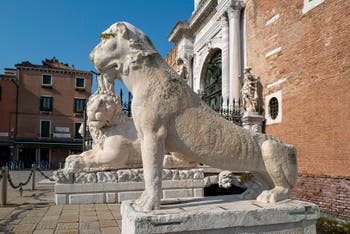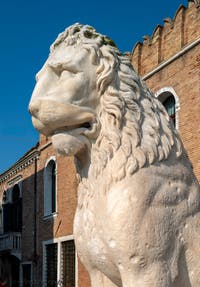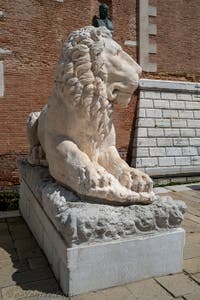Squares Arsenal | Hunchback | Dogana | Colleoni | Rioba | Piazzetta St. Mark | Stefano | Rialto Vecchio
The Greek Lions of the Venice Arsenal
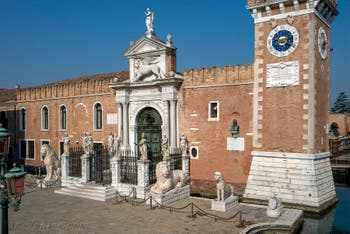
The four Greek lions in front of the Arsenale Four lions sit enthroned in front of the entrance to the Arsenale in Venice.
A major symbol in Venice where the Patron Saint of Venice is St. Mark, symbolically represented by a lion. But what's interesting about these Venetian lions is their history - not Venetian at all, but Greek!
They are in fact ancient lions that were 'stolen' from Greece by the Venetians.
The only thing Venetian about them is their location, since they were taken in war, and not always under glorious conditions for Venice.
The Lion of Piraeus, Catch of War by Francesco Morosini
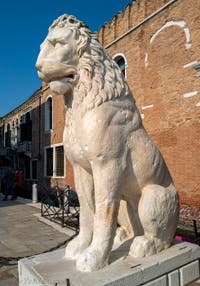
Lion of the port of Piraeus sculpture - Pentelic marble (Height: 3m80) - 570 BC
The best known of these four lions is the one that stands alone to the left of the entrance door to the Arsenale in Venice.
An impressive sculpture standing 3m80 tall.
It is one of those brought back to Venice in 1687 by the Peloponnesian, the future Doge Francesco Morosini.
Francesco Morosini led the troops that were to reconquer the Peloponnese from the Turks.
Among the places to be taken was the Parthenon in Athens, where the Turks had entrenched themselves.
No matter, monument to ancient civilisation or not, Francesco Morosini had a mortar aimed from the hill of Philopappos, and did not hesitate to fire on the Acropolis and its Parthenon.
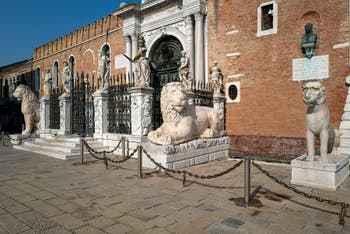
Three of the four lions of the Arsenal And so came the tragedy of 26 September 1687 with its catastrophic outcome.
Indeed, the Turks, having entrenched themselves at the top of the Acropolis, had stored their ammunition and barrels of gunpowder in the Parthenon.
So when Francesco Morosini fired straight at the Parthenon, with no regard for these ancient stones, the mortar round not only hit the temple, but also blew up the powder magazine!
The cella and frieze of the Parthenon were almost completely destroyed.
On the north side of the Parthenon, eight columns were also demolished, as were six others on the south side, including the entablatures!
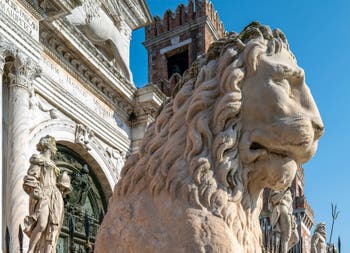
Lion from the port of Piraeus But Francesco Morosini didn't stop there.
He was keen to bring war trophies back to Venice, as Doge Enrico Dandolo had done before him by stealing the horses from St. Mark's Basilica in Constantinople.
Morosini, eager for fame and glory, asked his troops to remove Athena's chariot and carriage from the west pediment of the Parthenon temple.
Asking soldiers to play archaeologist and stonemason could only lead to a second catastrophe.
Athena and the carriage fell during the operation and were reduced to pebbles.
However, Morosini, who had already destroyed a large part of the Parthenon with mortar and then by hand, turned his attention to the Lion of the Port of Piraeus, a port aptly named "the Port of the Lion".

Lion of the port of Piraeus And it was this famous lion from the Port of Piraeus, the large lion to the left of the entrance to the Arsenal, that Morosini brought back to Venice.
This lion indicated the start of the road to Piraeus, while the second large lion on the other side of the entrance, that of Hepaistis, indicated the end of the same road.
At the foot of the lion of Piraeus, the inscription reads:
"FRANCISCVS MAVROCENVS PELOPONESIACVS
EXPVGNATIS ATHENIS MARMOREA LEONVM
SIMVLACRA TRIVMPHALI MANV è PIRAEO DIREPTA
IN PATRIAM TRANSTVLIT FVTVRA VENETI LEONIS
QVAE FVERANT MINERVAE ATTICAE ORNAMENTA"
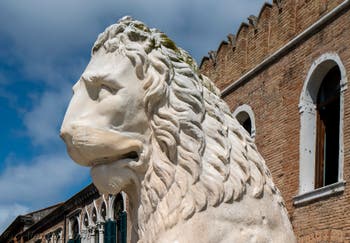
Lion from the port of Piraeus This lion in Penteelic marble (a mountain north of Athens from which high quality white marble was quarried as early as 570 BC and used to build the monuments and temples of the Acropolis as well as others in Athens) is particularly large and imposing: 3m80 high.
Some sources indicate that this lion was used as a public fountain.
But this false theory suffers from the fact that when you examine this lion closely, you can't see where the water could have come from at all; the mouth is in fact tightly closed, with no hole, not even a plugged one, just like the rest of the lion's body.
According to historians, this Lion of Piraeus was sculpted to celebrate the battles of Marathon and Salamis.
The Esoteric Lion with Runic Characters from the Venice Arsenal
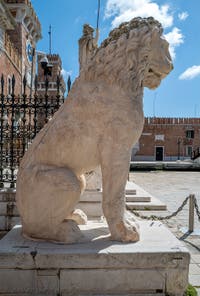
Lion from the port of Piraeus This large lion, before being torn from its Athenian sun was also "tattooed" with letters that at first sight were incomprehensible, turning it into an enigma for several centuries.
The famous Venetian cartoonist Hugo Pratt, father of Corto Maltese, considered it to be the oldest symbol of St. Mark, but without its attributes (the book between the legs with the inscription "Pax tibi Marce, Evangelista meus" - "Peace be with you, Mark my Evangelist").
In Hugo Pratt's "Fable of Venice", Corto Maltese goes in search of a magic emerald and pays a little visit to the great lion of the Arsenal with his famous runic characters, just to solve the riddle to find the treasure: some “Da Vinci Code” or “Inferno” Dan Brown-style in advance!
But the mystery was cleared up after 1800, thanks to a Swede called Akerblad who guessed that the characters engraved on the lion were runic.
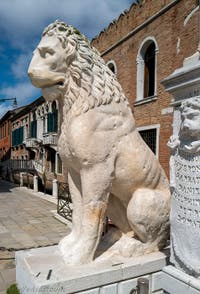
Lion of the port of Piraeus It was finally a Dane, C.G. Rafn, who managed to translate them in full in 1856.
He realised that the inscription contained not only runic characters, but also an ancient Danish idiom that was widely spoken in northern Europe.
What's more, in 1856 the language used on the lion's body was still more or less in use in some of Iceland's lost moors.
It was thus discovered that this mysterious inscription had been engraved by mercenary soldiers of Scandinavian origin who had served under the orders of the emperor of Byzantium, Michael IV the Paphlagonian, to put down a revolt against a tax levy in the city of Athens in 1040.
These Viking warriors from the Byzantine emperors' Varangian guard, led by their leader Harold the Great, simply wanted to leave a trace of their passage through Piraeus by engraving the lion with an account of their military exploits!
The translation of the inscription on the lion's left shoulder, dating from 1040, reads as follows:
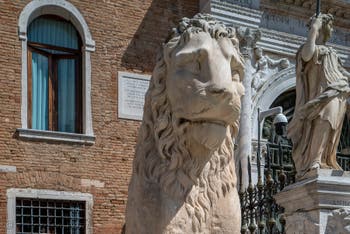
Lion from the port of Piraeus On the left shoulder of the lion, the translation of the inscription dating from the year 1040, gives the following:
“Haakon with Ulf, Asmund and Orn, conquered this port. These men received large sums because of the revolt of the Greek people.
Dalk was a captive in distant lands. Egil waged war in Romania and Armenia with Ragnar ”
And on the lion's right hip, the inscription is quite simply... a signature!
“On the orders of Harold the Great, Asmund engraved these runes with the help of Asgeir, Thorleif, Thord and Ivard, although the Greeks objected.”
The Lion of the Sacred Way in the Temple of Hephaestus
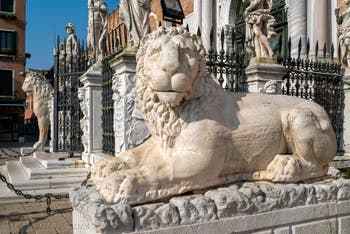
The lion of Hephaestus from the Sacred Way Scultpure - Pentelic marble - 4th century BC
The second large lion, no longer seated, but this time reclining to the right of the entrance to the Arsenal, dates from the 4th century BC.
This lion comes from the Sacred Way that linked Athens to Eleusis and stood at the foot of the Temple of Hephaestus.
This lion also indicated the end of the road to Piraeus, while the first large lion, that of the port of Athens, indicated the beginning of the same road.
The lion of Hephaestus, like the one from the port of Piraeus, was brought back to Venice in 1687 by Francesco Morosini.
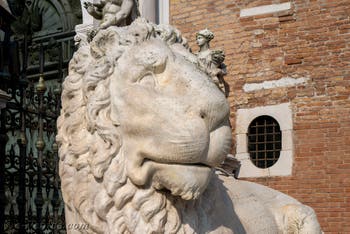
The lion of Hephaestus from the Sacred Way It was installed in front of the Venice Arsenal, along with the lion from the port of Piraeus, in 1688.
In 1692, the Venetian Senate had the following inscription engraved on the lion's base:
"ATHENIENSIA VENETÆ
CLASSIS TROPHŒA
VENETI SENATVS
DECRETO IN NAVALIS
VESTIBVLO CONSTITVTA"
The Greek Lions of the Venice Arsenal: A 2,600-year-old Old Lion!
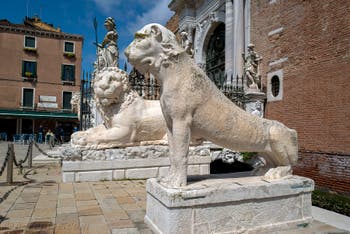
Lion of the Greek island of Delos Two other, much smaller lions, which were also warrior trophies, are positioned to the right of the lion of Hephaestus, between it and the Rio de l'Arsenal.
They were wrongly named “Lions of Dandolo” after the famous Doge Enrico Dandolo, who had already brought the quadriga from St. Mark's Basilica to Venice.
Some have suggested that he took advantage of his plundering in Constantinople to bring these two little lions back to Venice.
But we now know that the history of these lions is very different and that the name “Lions of Dandolo” has no historical basis.
The Lion of Delos, the oldest lion in the Venice Arsenal
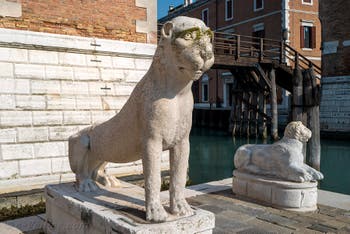
Lion of the Greek island of Delos Scultpure - Marble - 6th century BC
The first of these two lions, the one next to the lion of Hephaestus, decorated a terrace on the island of Delos.
This lion was part of a group made up of several lions, five of which still exist on the island of Delos.
It is also known that the lion's head was added.
Not only is the head shown disproportionately large in relation to the rest of the body, it also bears no resemblance to the heads of the five lions that can still be seen in Delos.

Lion of the Greek island of Delos This lion is believed to be a sculpture from the ancient Greek school of Naxos, from the 6th century BC.
This lion was brought back to Venice as a prize of war by Admiral Pisani, whose ships had stopped at the island of Delos to replenish their supplies of fresh water.
It was installed in the Arsenal to commemorate the victory of the Venetians over the Ottomans during the assault on the town of Corfu in 1716, as confirmed by the inscription engraved in its base:
"ANNO CORCYRÆ
LIIRATÆ"
The Molossus of the Athens Acropolis
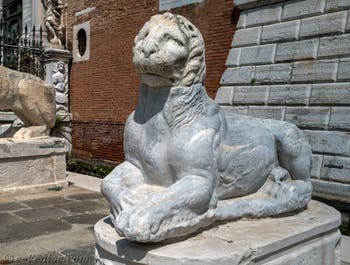
Molossus from the Acropolis of Athens Scultpure - Marble - 360 BC
As for the lioness, lying next to the Rio de l'Arsenal, it bears an inscription that could not be dated:
"E X
ATTICIS"
However, the head of this pseudolion is more recent than its body.
It is considerably smaller and was sculpted in Venice and added in the 18th century.
And this error of proportions, but also of gender, has now been clarified since this lioness was in fact a Molosse or a Dogue.
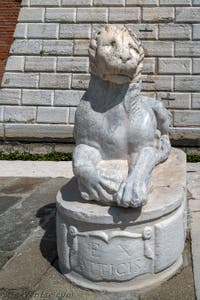
Molossus from the Acropolis of Athens When Morisini stole the statue, it was already headless and he thought it was a lioness.
This misjudgement of the animal's nature is now certain, since in the 1960s the missing head was found in Athens, and it is indeed that of a Molossus!
Thanks to the recovered head, we now know that this Hymettus marble molossus came from the tombs on the western slope of the Acropolis and was intended to protect the dead.
Following this discovery, we also know that this Molossus was sculpted around 360 BC.
The lions in the Venice Arsenale have also been the subject of much writing, including by Goethe:
“At the arsenal stand at rest two lions of ancient Greece.
The gate, tower and canal look petty next to this pair.
Lion from the Greek island of Delos If the mother of the gods came down, they would both clutch her chariot and she would rejoice in her carriage. But now they stand there, melancholy.
The modern winged tomcat wheels everywhere, and it is he whom Venice names its patron.”
Goethe Epigrams Venice 1790
Goethe who, in his memoirs, also cites the famous marble lions in the Penteelic in the Venice Arsenal:
“Speaking of the Arsenal, I forgot to mention the two white marble lions which decorate the portal, and which caused me as much surprise as admiration.
They are so big that everything around them seems small.
It is said that they date from the most glorious period of Greek art”
Goethe - Memoirs 1786
The Runic Lion of Piraeus at the Venice Arsenal
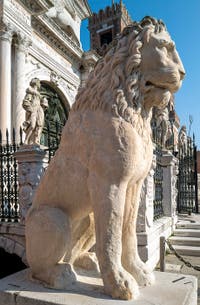
Lion of the port of Piraeus Théophile Gautier also admired them:
“The two colossi in pentelic marble are devoid of that zoological truth which Barye would doubtless have given them.
But there is something about them that is so proud, so grandiose, so divine, if that word can be applied to animals, that they produce a deep impression.
Their golden whiteness stands out admirably against the red facade of the Arsenal, composed of a portico populated by statues of merit nevertheless, that this terrible neighbourhood makes look like dolls, and of two red brick turrets crenellated and hemmed in with stone, like the houses on the Place Royale in Paris.
Trophies of defeat, but still retaining their haughty and superb countenance, these lions seem to recall, in the city of St. Mark, the Attic Minerva.
And the great Goethe celebrated them in an epigram that we translate here, asking forgiveness for substituting our puny verses for the Olympian rhythms of the Weimar Jupiter:
Lion from the port of Piraeus Two large lions brought from Attica
Stand sentinel at the Arsenal walls,
Peacefully, and close to the ancient couple,
All is small, gate, tower and canal.
They seem made for the chariot of Cybele,
So proud are they, and the mother of the gods
Would like to bend their rebellious necks to the yoke,
If she left the heavens for earth.
But now they guard the postern,
Sad, without glory, and one hears here
The modern winged cat mewing everywhere,
That Venice has chosen as its patron!”
Théophile Gautier - Italia (1855)
Francesco Morosini was not spared by some either:
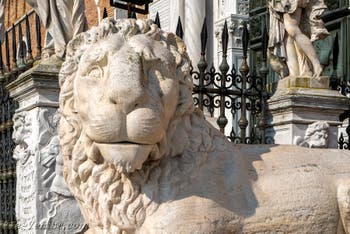
The lion of Hephaestus from the Sacred Way
“Even more surprising are the two gigantic lions guarding the entrance to the armoury, which we examined as we finished.
Masterpieces of ancient statuary, one taken from Athens, the other from Corinth, by Doge Morosini, the conqueror of the Turks, but the unintelligent devastator of the Parthenon.
Strangely and inexplicably, these two marbles bear characters from the alphabet of the ancient Scandinavians, which had only sixteen letters, and which can still be found in Sweden.
Did these runic prints come down from the North, or did they come up from the South?
Lion of the port of Piraeus It is to this last supposition that we turn, and everything leads us to believe that these horizontal and vertical bars derive from Phoenician, and that they will have been brought to the Baltic by some sailors from Tyre or Sidon, regarded as the first navigators of antiquity.”
Noémie Dondel du Faouëdic - Souvenirs (1875)
While Michelet roared with pleasure:
“It's a very different animal, than the colossal lion that stands at the gate of the Arsenal.
Motionless and angry, it looks like Salamis roaring....
It is not a noble and human lion, like Thorwaldsen's; it is a lion-god, the terrible genius of the Medieval wars, in which Europe seems ready to devour Asia...;
Jules Michelet - On the Roads of Europe (1893)
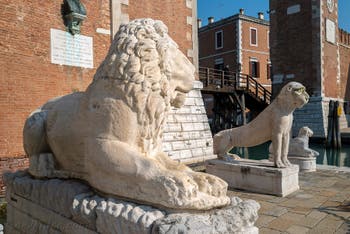
The lion of Hephaestus from the Sacred Way Jean-Baptiste Trumet de Fontarce was very close to the truth about the lion of Piraeus:
“A simple gate closes the entrance (the Arsenal), and in front of this gate four lions, three of which are antique and one modern.
Among the first lions, one in particular caught our eye. Its effect is astonishing. Sitting with his eyes fixed and his head held high, he is considered to be the most beautiful of his kind.
On its back are a number of characters that have exercised the sagacity of scholars.
It is believed to date from five to six hundred years before Christ, from a century before Phidias; it is presumed from the order of the characters drawn from right to left, the manner of the time.
The four Greek lions in front of the Arsenal So that it is possible, say scholars, that it is a monument to the victory of Marathon, the year 490.
Pausanias tells us that the Thebans erected a lion in memory of warriors who died for their country. And this lion is in Venice, where it had come from Constantinople.”
Jean-Baptiste Trumet de Fontarce
Impressions of a journey in Italy (1897)
Finally, Töpffer talked about it with great passion:
“We admire, on both sides of the door, two c'olossal lions, which were transported from Athens to Venice in 1687 by François Morosini.
The lion of Hephaestus These lions, which, before adorning the threshold of this arsenal, have, for two thousand years, weighed down the piers of Piraeus with their weight, are certainly frustrated, but of such vigour of style, that even today, as on the day they left the sculptor's workshop, they have their whole character of power, of severe pride, of imposing and monumental majesty.
It is not the hardness of the block, it is not the colossal scale of the proportions that ensure a glorious duration to the productions of statuary.
It is rather this energetic imprint of human thought, this firmly grasped accuracy of character, this poetic abstraction of attributes, which, coming to be marked in the style, make the primitive expression of the work survive the injures of time and the very mutilations of men, preserve, retain, eternalise the spark of life, the breath of grace, the fire of indelible passion, even in a shattered torso, even in a frustrated section.”
R. Töpffer - Zigzag journeys (1842)
Squares Arsenal | Hunchback | Dogana | Colleoni | Rioba | Piazzetta St. Mark | Stefano | Rialto Vecchio
Back to Top of Page


